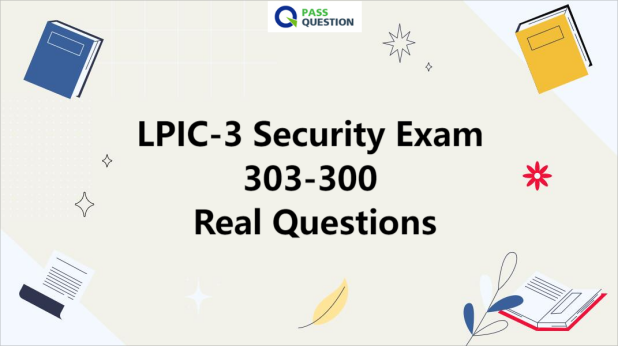LPIC-3 Security Exam 303-300 Real Questions
The LPI 303-300 certification is perfect for individuals who are looking to expand their understanding of Linux System Security. If you're interested in gaining in-depth knowledge and practical skills in this field, the latest LPIC-3 Security Exam 303-300 Real Questions provided by the PassQuestion team are an excellent resource to assist you in successfully passing your exam. These LPIC-3 Security Exam 303-300 Real Questions have been carefully designed to cover all the important topics and ensure that you are well-prepared for the certification exam. With the help of these comprehensive LPIC-3 Security Exam 303-300 Real Questions, you can confidently approach the exam and enhance your chances of achieving a favorable results.

LPIC-3 Certification
The LPIC-3 certification is the culmination of the multi-level professional certification program of the Linux Professional Institute (LPI). LPIC-3 is designed for the enterprise-level Linux professional and represents the highest level of professional, distribution-neutral Linux certification within the industry. Four separate LPIC-3 specialty certifications are available. Passing any one of the four exams will grant the LPIC-3 certification for that specialty.
The LPIC-3 Security certification covers the administration of Linux systems enterprise-wide with an emphasis on security. To receive the LPIC-3 Security certification, you must be LPIC-2 certified and pass the 303 exam
Exam Information
Current version: 3.0 (Exam code 303-300)
Number of Questions: 60 multiple-choice
Duration: 90-minute
Format: multiple-choice and fill in the blank questions
Requirements: Passing the 303 exam.
Validity period: 5 years
Languages for exam available in VUE test centers: English, Japanese
LPIC-3 Security Exam 303 Objectives
Cryptography
- X.509 Certificates and Public Key Infrastructures
- X.509 Certificates for Encryption, Signing and Authentication
- Encrypted File Systems
- DNS and Cryptography
Host Security
- Host Hardening
- Host Intrusion Detection
- Resource Control
Access Control
- Discretionary Access Control
- Mandatory Access Control
Network Security
- Network Hardening
- Network Intrusion Detection
- Packet Filtering
- Virtual Private Networks
Threats and Vulnerability Assessment
- Common Security Vulnerabilities and Threats
- Penetration Testing
View Online LPIC-3 Security Exam 303-300 Free Questions
1. Which option of the openvpn command should be used to ensure that ephemeral keys are not written to the swap space?
A. --mlock
B. --no-swap
C. --root-swap
D. --keys-no-swap
Answer: A
2. A LUKS device was mapped using the command: cryptsetup luksOpen/dev/sda1 crypt-vol
Given that this device has three different keys, which of the following commands deletes only the first key?
A. cryptsetup luksDelKey /dev/sda 1 0
B. cryptsetup luksDelkey /dev/sda 1 1
C. cryptsetup luksDelKey / dev /mapper/crypt- vol 1
D. cryptsetup luksDelKey / dev /mapper/crypt- vol 0
Answer: B
3. In which path is the data, which can be altered by the sysctl command, accessible?
A. /dev/sys/
B. /sys/
C. /proc/sys/
D. /sysctl/
Answer: C
4. What is the purpose of the program snort-stat?
A. It displays statistics from the running Snort process.
B. It returns the status of all configured network devices.
C. It reports whether the Snort process is still running and processing packets.
D. It displays the status of all Snort processes.
E. It reads syslog files containing Snort information and generates port scan statistics.
Answer: E
5. Linux Extended File Attributes are organized in namespaces. Which of the following names correspond to existing attribute namespaces? (Choose THREE correct answers.)
A. default
B. system
C. owner
D. trusted
E. user
Answer: B, D, E
6. When OpenVPN sends a control packet to its peer, it expects an acknowledgement in 2 seconds by default. Which of the following options changes the timeout period to 5 seconds?
A. -- tls-timeout 5
B. -- tls- timeout 500
C. -- tls- timer 5
D. -- tls- timer 500
Answer: A
7. How are SELinux permissions related to standard Linux permissions? (Choose TWO correct answers.)
A. SELinux permissions override standard Linux permissions.
B. Standard Linux permissions override SELinux permissions.
C. SELinux permissions are verified before standard Linux permissions.
D. SELinux permissions are verified after standard Linux permissions.
Answer: B, D
8. Which of the following commands makes the contents of the eCryptfs encrypted directory ~/Private available to the user?
A. ecryptfsclient
B. ecryptfs.mount
C. ecryptfs-mount-private
D. decryptfs
E. ecryptfs-manage-directory
Answer: C
9. What effect does the following command have on TCP packets?
iptables- A INPUT d 10.142.232.1 p tcp --dport 20:21 j ACCEPT
A. Forward all TCP traffic not on port 20 or 21 to the IP address 10.142.232.1
B. Drop all TCP traffic coming from 10.142.232.1 destined for port 20 or 21.
C. Accept only TCP traffic from 10.142.232.1 destined for port 20 or 21.
D. Accept all TCP traffic on port 20 and 21 for the IP address 10.142.232.1
Answer: D
10. Which of the following resources of a shell and its child processes can be controlled by the Bash build-in command ulimit? (Choose THREE correct answers.)
A. The maximum size of written files
B. The maximum number of open file descriptors
C. The maximum number of newly created files
D. The maximum number of environment variables
E. The maximum number of user processes
Answer: A, B, E
- TOP 50 Exam Questions
-
Exam
All copyrights reserved 2025 PassQuestion NETWORK CO.,LIMITED. All Rights Reserved.

